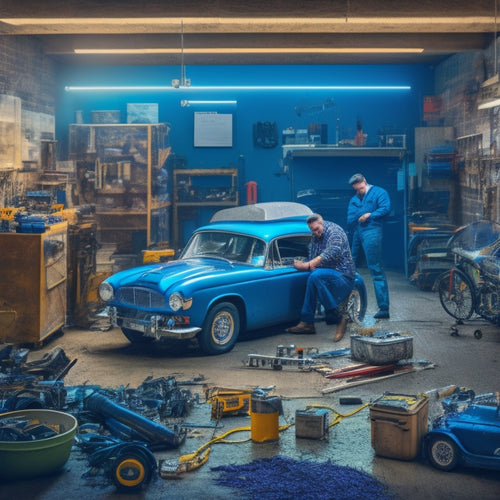
5 Best Practices for Cleaning Home Solar Panels
Share
To maximize your home solar panels' energy output, follow these 5 best practices for cleaning. First, prepare a gentle cleaning solution with deionized water and mild dish soap. Remove debris like leaves and twigs, and inspect the panels for hotspots using an infrared camera. Clean the panels safely and efficiently with a soft-bristled brush, microfiber cloth, and extension pole. Finally, schedule regular maintenance to avoid energy losses and prolong panel lifespan. By following these steps, you can increase energy output by up to 25% and keep your electricity bills in check - and that's just the beginning of optimizing your solar panels' performance.
Key Takeaways
• Mix a gentle cleaning solution of 1 gallon of warm water with 1 tablespoon of mild dish soap, avoiding harsh chemicals.
• Remove debris and dust regularly, as they can reduce energy output by up to 25% and cause hotspots.
• Inspect panels for hotspots using an infrared camera, targeting cleaning efforts to maximize energy production.
• Clean panels safely and efficiently using soft-bristled brushes, deionized water, microfiber cloths, and extension poles.
• Schedule regular cleaning and inspection sessions, ideally at the start of each season, to maintain panel efficiency and prolong lifespan.
Prepare Your Cleaning Solution
Mix 1 gallon of warm water with 1 tablespoon of mild dish soap to create a gentle cleaning solution that won't scratch or damage your solar panels. You want to avoid using harsh chemicals, which can safeguard the integrity of your panels. Instead, opt for a mild dish soap that's free of abrasives and phosphates.
When it comes to water quality, use deionized or distilled water to minimize mineral deposits that can leave streaks or spots on your panels.
If you're concerned about the environmental impact of your cleaning solution, consider using eco-friendly alternatives like white vinegar or a mixture of equal parts water and hydrogen peroxide. These chemical alternatives are gentle on your panels and the environment. Remember to always spot test your cleaning solution on a small area of the panel first to make sure it won't damage the material.
With your gentle cleaning solution in hand, you're ready to tackle the dirt and grime that's blocking your solar panels' energy potential.
Remove Debris and Dust
Your solar panels are now ready for a thorough cleaning, starting with the removal of loose debris and dust that can obstruct sunlight and reduce energy output. This critical step is often overlooked, but it's vital to maximize your solar panel's performance. Debris consequences can be severe, leading to reduced energy production and even panel damage. Dust accumulation, in particular, can decrease energy output by up to 25%!
Before you start cleaning, take a few minutes to remove any loose debris, such as:
-
Leaves: Those pesky autumnal leftovers can block sunlight and cause hotspots.
-
Twigs: Those tiny branches can scratch your panels or get stuck in the frames.
-
Dirt clods: Clumps of dirt can accumulate and reduce energy output.
- Bird droppings: Yep, those unwanted presents from our feathered friends can be a real nuisance.
Inspect and Identify Hot Spots
With your solar panels now cleared of loose debris, inspect the surface for hotspots, which can be indicative of more stubborn grime or mineral deposits that require targeted cleaning. You're not just looking for visible dirt; you're on a mission to detect thermal anomalies that can reduce your panel's efficiency. This is where thermal imaging comes in handy. Using an infrared camera or scanner, you can identify areas with abnormal heat signatures, which often indicate dirt buildup or mineral deposits. These hotspots can be a real energy-suck, so it's crucial to pinpoint them before they reduce your panel's performance.
As you inspect your panels, keep an eye out for areas with higher temperatures, which can indicate grime or mineral buildup. Use your infrared scanning skills to detect these hotspots and make a mental note (or better, a physical note) of their location. This will help you target your cleaning efforts and ensure a more efficient cleaning process. Remember, a clean panel is a happy panel – and a happy panel is one that's producing maximum energy!
Clean Panels Safely and Efficiently
Safety first: prior to starting cleaning, make sure you're equipped with the right gear and a solid understanding of the techniques to avoid damaging your panels or putting yourself at risk. You don't want to be that person who turns a simple cleaning task into a costly repair job!
When it comes to panel maintenance, you'll need the right cleaning tools for the job. Here are some essentials to get you started:
-
Soft-bristled brush: Gentle on panels, tough on dirt and debris.
-
Deionized water: No minerals, no streaks, no residue.
-
Microfiber cloth: Absorbs dirt and water like a pro.
- Extension pole: Reach those hard-to-reach panels without risking life and limb.
Schedule Regular Maintenance
To keep your solar panels running at peak performance, you'll need to schedule regular cleaning and inspection sessions to prevent dirt and debris buildup. Think of it like maintaining your car - you wouldn't drive 10,000 miles without an oil change, right?
Set seasonal reminders to clean your panels at the start of each season, when pollen, leaves, or snow might be affecting their efficiency. Consider investing in a maintenance contract with a reputable solar panel cleaning service. They'll take care of the dirty work (literally!) and make sure your panels are running at their best levels.
With regular maintenance, you'll avoid energy losses, prolong the lifespan of your panels, and keep those electricity bills in check. Don't let dirt and debris steal your solar power thunder - stay on top of maintenance and reap the benefits of clean, green energy!
Frequently Asked Questions
Can I Use Household Cleaners on Solar Panels?
Don't even think about using household cleaners on your solar panels, as they can leave behind detergent risks that trigger chemical reactions, damaging the panels and reducing their efficiency - not worth the risk, trust us!
Do I Need to Clean My Solar Panels in Winter?
In winter, you'll want to clean your solar panels, especially after snowy conditions, to remove winter debris like snow, leaves, and twigs that can reduce energy output by up to 25%.
Can I Clean Solar Panels During Peak Sun Hours?
"You're wise to wonder if you can clean solar panels during peak sun hours, but beware: thermal expansion might cause damage, and energy loss will occur if you clean when the panels are hot - avoid it!"
How Often Should I Inspect My Solar Panels for Damage?
You should inspect your solar panels quarterly for signs of Panel Degradation, performing a Visual Inspection to catch issues before they snowball into major problems, ensuring your system runs efficiently and effectively.
Can I Clean Solar Panels With a High-Pressure Washer?
"Don't even think about blasting your solar panels with a high-pressure washer! Keep the water pressure low and the spray distance far to avoid damaging those delicate cells - you don't want to rinse away your energy savings!"
Related Posts
-

5 Essential Tips for Buying EV Charging Systems Online
When purchasing an EV charging system online, you'll want to make sure you're making an informed decision. First, det...
-

Step-by-Step Guide to Converting Your Vehicle to EV
You'll begin by evaluating your vehicle's conversion potential, analyzing its weight, aerodynamics, and powertrain co...
-

What Makes a Road Bike-Friendly by Design?
As you plan and design roads, incorporating features like dedicated bike lanes, smooth surfaces, and traffic calming ...


